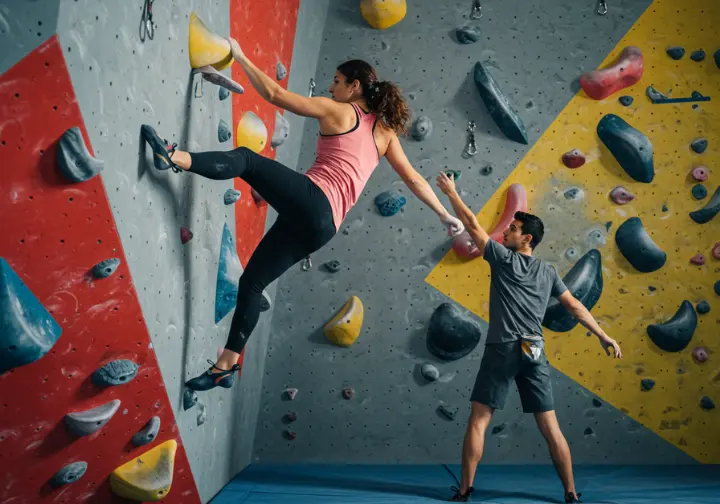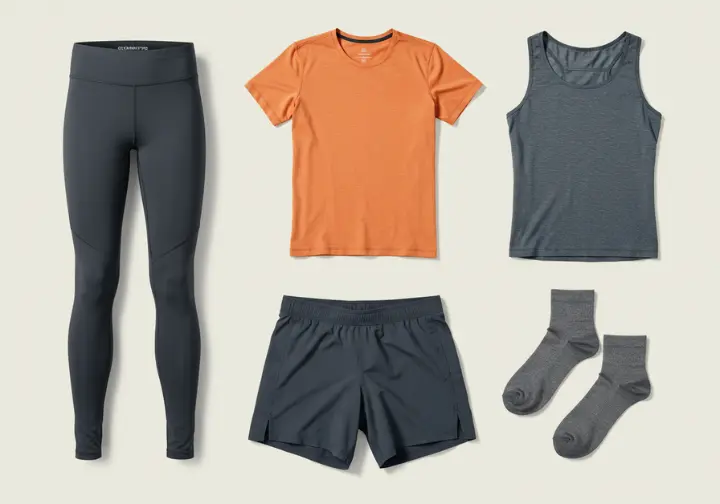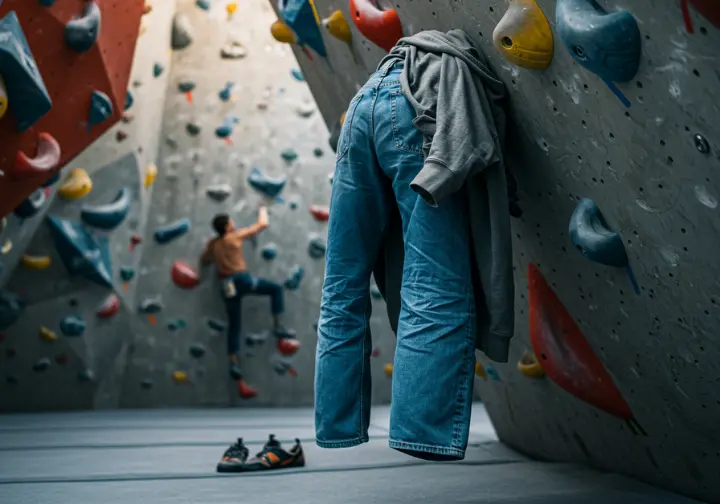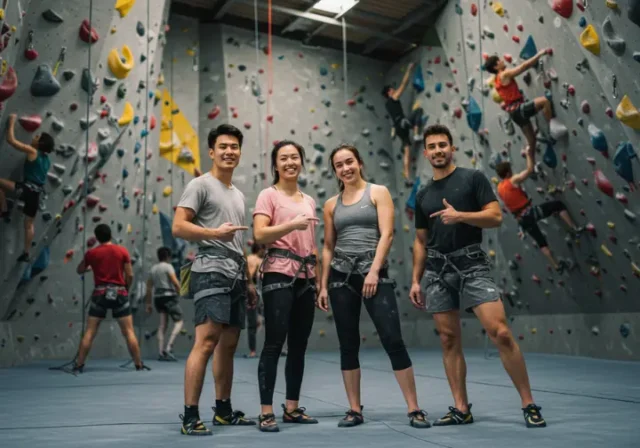In this article
Knowing exactly what to wear indoor rock climbing can feel like one of the first hurdles to overcome. The good news is you almost certainly don’t need to buy special climbing clothes to get started. The main goal for a beginner’s climbing outfit is comfort and freedom of movement, which means most people already have suitable athletic apparel in their closet. The climbing gym provides all the essential climbing equipment like harnesses, and you can rent critical items like climbing shoes and chalk bags. This guide will break down the simple principles of what makes clothing great for climbing, what to pull from your own wardrobe, and what to leave at home, ensuring you feel confident and ready for a great first experience.
Why Your Everyday Athletic Wear is Perfect for Starting

You don’t need a specialized wardrobe to start climbing; your current fitness clothes are likely perfect. We’ll explore the core principles that make clothing suitable for the indoor climbing venue, focusing on factors like mobility, breathability, and durability. Understanding why certain clothes work well will empower you to confidently pick an outfit that helps you perform your best during the actual climbing part.
The Principle of Unrestricted Movement
Climbing involves a huge variety of movements, including high steps, wide stances, and long reaches. Because of this, freedom of motion is the most critical factor in your clothing choice. Your apparel must allow your arms, legs, and torso to move without any restriction to execute techniques properly. This is why materials with built-in stretch, like flexible fabrics containing spandex or elastane, are highly recommended.
While specialized, climbing-specific pants from brands like Mammut often have features like a gusseted crotch or articulated knees to enhance mobility, you can achieve the same functional freedom with common gym attire. Yoga pants, leggings, and stretchy athletic shorts are perfect examples of nonrestrictive clothing that allows for a full range of motion. Just as restrictive jeans can be problematic, wearing clothing that is too tight can also hinder your ability to lift your legs for high footholds or position your body effectively. The goal is a comfortable fit that moves with you, not against you.
Comfort, Breathability, and Durability
Comfort is paramount when you’re on the vertical wall. If your clothing is distracting you on the ground with chafing fabrics or digging seams, that feeling will only be amplified during a climb, breaking your concentration. Comfort also extends to temperature regulation. Climbing is a great workout indoor, and a good sweat is common, so choosing breathable, moisture-wicking fabric is a key consideration for staying comfortable.
Materials like polyester and nylon are excellent because these lightweight materials pull moisture away from the skin, helping you stay cooler and drier. In contrast, 100% cotton should be used with caution as it absorbs sweat, becomes heavy, and can leave you feeling cold and clammy during rest periods. If you prefer the feel of cotton, a cotton-synthetic blend offers a good compromise. Indoor climbing walls have abrasive surfaces, so durability is another factor. Choosing clothes made from durable materials will help your gear last longer.
The Importance of Proper Fit
Finding the right fit is a critical balancing act. Excessively loose or baggy clothing with extra fabric poses a genuine safety hazard, as it can easily get caught on climbing holds or interfere with gear like belay devices. This risk makes it important to choose well-fitting garments that stay close to your body.
Beyond the safety aspect, fit also impacts performance. Dangling drawstrings or overly wide pant legs can obscure the view of your feet. Since precise footwork is a cornerstone of good climbing technique, being able to see where you place your feet is essential for your success on the wall. A comfortably snug fit that moves with your body is the ideal you should aim for. This ensures nothing gets in the way of your movement, your gear, or your line of sight.
What to Wear Climbing: A Head-to-Toe Guide from Your Closet

Ready to pick an outfit? Here are specific, actionable recommendations for what you can pull from your existing wardrobe. We’ll break down the best choices for tops and bottoms, explain the pros and cons of common items like leggings and shorts, and clarify the sock situation with rental shoes. This will answer the common question of what to wear to go indoor rock climbing.
Best Tops: T-Shirts and Tank Tops
For your top, the best choices are standard athletic t-shirts or sleeveless shirts that you would wear for any other gym activity. For women, wearing sports bras underneath is common for support. The most important requirement is that the garment allows for complete freedom of movement in your arms and shoulders, enabling you to reach, pull, and twist without any restriction.
As mentioned earlier, synthetic fabrics are highly recommended over 100% cotton. These materials excel at wicking moisture away from your skin, which keeps you feeling cooler and prevents the uncomfortable, clingy feeling of a sweat-soaked shirt. Fit is also important for climbing tops; avoid anything excessively baggy. A loose shirt can snag on holds or, more critically, obscure your view of your harness and belay loop when you need to check your gear.
Bottoms: Leggings, Joggers, or Shorts?
When it comes to bottoms, stretchy options are ideal. Yoga pants, leggings, or athletic joggers are excellent choices for both men and women, as their high stretch content allows for the high steps and wide stances essential for climbing. They also provide a good layer of skin protection against scrapes from the textured wall. Many experienced climbers eventually invest in durable Mammut climbing pants, but this isn’t necessary at first.
Athletic shorts are another great option, especially in warmer gyms, as they offer maximum freedom for knee movement. The main trade-off is less skin protection, particularly for your knees, which are prone to getting scraped. If you plan to do roped climbing, be aware that very short shorts can sometimes bunch up uncomfortably under the leg loops of a climbing harness. For this reason, many climbers choose pants or bottoms that are at least mid-thigh length or longer to ensure comfort.
Footwear: Rental Shoes and Sock Choices
While you don’t need specialized clothing, you absolutely need proper climbing shoes; regular sports shoes simply won’t work. Fortunately, every climbing gym rents them, and they are essential for a good first experience. These rock shoes are designed with sticky rubber soles and a precise fit to help you stand on even the smallest of footholds. The bad news—climbing shoes are a must; the good news—climbing gyms rent them out.
When you get your rental shoes, the staff will help you find the right size, which should be “comfortably snug” but not painfully tight. For hygiene and comfort, wearing a pair of thin athletic socks with rental shoes is the best choice for beginners. Socks provide a barrier in shared shoes and can help improve the fit if the shoes are slightly worn. You should avoid thick or bulky socks, as they will reduce your ability to feel the holds and can create uncomfortable pressure points inside the snug-fitting climbing shoes. For those thinking about transitioning from rental to personal climbing shoes after a few climbing sessions, this first experience is a great introduction.
Attire Adjustments for Different Climbing Styles and Gyms

Your clothing choice might shift slightly depending on your activity at the gym. We’ll clarify the subtle differences between dressing for bouldering versus top-rope climbing and explain why layering is a smart strategy for managing comfort and temperature throughout your session, whether you’re at a local gym or a renowned indoor facility like Brooklyn Boulders.
Bouldering vs. Roped Climbing Attire
The primary difference in what to wear for bouldering versus roped climbing comes down to one piece of gear: the harness. Indoor bouldering is performed on shorter walls without ropes or harnesses, which gives you more freedom in your clothing choices, especially when it comes to bottoms. Shorts of any length are common for bouldering, though some climbers still prefer long pants for extra knee protection, as bouldering can involve more dynamic falls onto the mats.
For roped climbing (such as top-rope climbing, which is most common for beginners), your clothes needs to be harness-compatible. This means your bottoms should be fitted enough that they don’t bunch up uncomfortably under the harness, and your top shouldn’t be so baggy that it obstructs your view of the belay loop. For this reason, longer shorts, capris, or pants are often more comfortable when wearing a harness.
The Smart Strategy of Layering
Climbing gyms can have fluctuating temperatures; some air-conditioned indoor venues are cool, while a gym heater might be on in winter. A typical session also includes periods of intense activity followed by rest, such as when you are belaying a partner or planning your next move. During these inactive moments, it’s easy to get cold, especially if you’ve been sweating through a warm-up routine or a sweat-inducing crux.
The best way to manage this is to bring an extra layer, like a comfortable hoodie, sweatshirt, or a light jacket. You can wear this layer during your initial warm-up, take it off when you start climbing actively, and then put it back on during rests or after your session. This simple practice of layering allows you to regulate your body temperature effectively, ensuring you stay comfortable throughout your entire time at the gym.
The “Definitely Don’t Wear” List

Just as important as what to wear is what not to wear. To help you avoid common mistakes, we’ll outline the clothing and accessories you should leave at home. This includes restrictive items like jeans, potentially hazardous apparel, and things like gloves that are actually counterproductive for climbing.
Clothing to Leave at Home
The number one thing to avoid is restrictive clothing. This includes traditional, non-stretchy jeans, stiff canvas pants, or any other fabric that won’t allow you to lift your knees high or spread your legs for a stable stance. Trying to climb in restrictive pants is incredibly frustrating and will severely limit your movement from the moment you step on the climbing wall.
While comfort is important, clothing that is too loose or baggy can be a significant hazard. Dangling drawstrings, oversized hoodies, or very wide-leg pants can easily snag on climbing holds or get caught in a belay device, creating a dangerous situation. It is also a good practice to remove any jewelry that dangles or could get caught, such as long necklaces, bracelets, and even wristwatches, as they can snag on holds or gear.
Why Gloves and Street Shoes Are a No-Go
It might seem intuitive to wear gloves to protect your hands from the rough texture of the holds, but they are not recommended for climbing. Gloves significantly reduce your ability to feel and grip the holds properly, which hinders the development of good technique and fundamental grip strength. Your hands will toughen up over time with practice.
Climbing gyms have a strict rule about not wearing street shoes on the padded climbing floor or the walls themselves. This is a hygiene and safety policy designed to keep the surfaces clean. Dirt from outside makes the holds and floor slippery and unsafe for everyone. You will use your rental climbing shoes on the mats and walls, and you can bring a pair of casual slip-on shoes or flip-flops to wear when walking around other parts of the gym. Climbing in sneakers is not allowed, and doing so is a major breach of gym etiquette.
Key Takeaways for Your First Climb
Dressing for your first indoor climbing session is simple and accessible. Knowing what to wear when indoor rock climbing is about being comfortable and confident so you can focus on the fun of learning a new skill.
- The most important takeaway is to prioritize comfort and mobility. Choose stretchy, breathable athletic clothes that you already own and feel good in.
- You do not need to buy any special technical clothing to start. Your existing gym clothes, like yoga pants, joggers, shorts, and a synthetic t-shirt, are perfect.
- The gym will provide all necessary safety and performance gear for rent, including your harness and climbing shoes. Your only job is to show up in comfortable apparel.
- Avoid restrictive clothing like jeans and overly baggy items that can snag on holds. Layering with a hoodie or sweatshirt is a smart strategy.
- Climbing culture values effort and enthusiasm far more than gear or apparel. Wear what makes you feel ready to move, and focus on enjoying the process.
Frequently Asked Questions about What to Wear Indoor Climbing
Can I just wear jeans for indoor climbing? +
What is better for climbing, shorts or leggings? +
Do I have to wear socks with rental climbing shoes? +
Will I look out of place if I don’t have expensive climbing clothes? +
We are a participant in the Amazon Services LLC Associates Program, an affiliate advertising program designed to provide a means for sites to earn advertising fees by advertising and linking to Amazon.com. As an Amazon Associate I earn from qualifying purchases. We also participate in other affiliate programs. The information provided on this website is provided for entertainment purposes only. We make no representations or warranties of any kind, expressed or implied, about the completeness, accuracy, adequacy, legality, usefulness, reliability, suitability, or availability of the information, or about anything else. Any reliance you place on the information is therefore strictly at your own risk. Additional terms are found in the terms of service.











